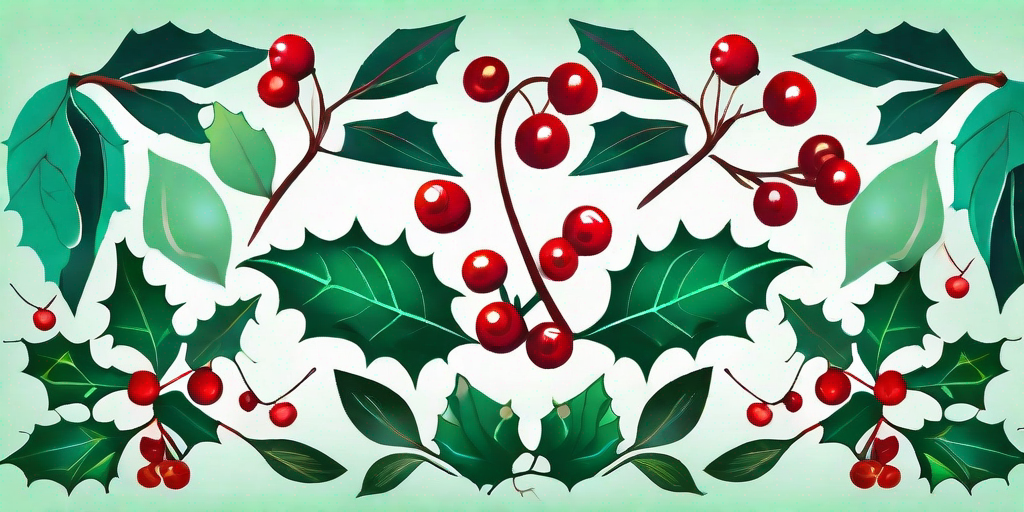
Welcome, berry enthusiasts and curious readers alike! Today, we're diving into the vibrant world of holly berries, those small, bright red fruits that adorn our homes during the festive season. But there's more to these berries than just holiday decor. So, buckle up and prepare for a sweet and tart adventure!
The Holly Berry Basics
Before we get into the juicy details, let's cover the basics. Holly berries, despite their name, are not true berries. They are drupes, which are fruits with a single seed or pit surrounded by a hard shell. This is the same family that gives us peaches, plums, and cherries. Now, isn't that a fun fact to share at your next dinner party?
These berries are produced by the holly tree, a plant species known for its glossy, spiky leaves and bright red fruits. While they are most commonly associated with Christmas decorations, holly trees are evergreen, meaning they retain their leaves and berries throughout the year. So, technically, every day could be Christmas if you have a holly tree in your backyard.
Types of Holly Berries
There are over 400 species of holly trees, each producing its unique variety of berries. Some of the most common types include the American holly, English holly, and the winterberry. Each of these species has its distinct features, but they all share the iconic red berry that we know and love.
The American holly, for instance, is known for its large, glossy leaves and bright red berries. The English holly, on the other hand, has smaller leaves and berries but is equally vibrant. The winterberry, true to its name, loses its leaves in winter, leaving behind a stunning display of red berries against the stark winter landscape.
The Sweet and Tart Taste of Holly Berries
Now, let's talk about the taste of holly berries. If you're expecting a sweet, juicy bite, you might be in for a surprise. Holly berries are known for their tart, slightly bitter taste. But don't let that deter you. With the right preparation, these berries can be transformed into a delightful culinary treat.
However, a word of caution before you start picking berries from your backyard holly tree. Holly berries are mildly toxic if consumed raw. They contain a compound called theobromine, the same substance found in chocolate that is toxic to dogs. So, while a few berries might not harm you, it's best to avoid eating them raw.
Using Holly Berries in Cooking
Despite their toxicity, holly berries have been used in cooking for centuries. They are often used to make jellies, jams, and sauces, where their tart flavor can be balanced with sugar and other sweeteners. Some adventurous chefs even use them in savory dishes, where their unique flavor adds a twist to traditional recipes.
When cooking with holly berries, it's essential to cook them thoroughly to break down the toxic compounds. This usually involves boiling the berries for at least 20 minutes. Once cooked, the berries can be strained to remove the seeds and hard shells, leaving behind a flavorful pulp that can be used in various recipes.
Decorative Uses of Holly Berries
Aside from their culinary uses, holly berries are also popular for their decorative appeal. Their bright red color and glossy finish make them a favorite for holiday decorations. From wreaths to centerpieces, these berries can add a festive touch to any setting.
But why limit their use to the holiday season? Holly berries can be used to brighten up your home throughout the year. Whether it's a simple vase of holly branches or a sophisticated floral arrangement, these berries can add a pop of color and a touch of nature to your decor.
Creating a Holly Berry Wreath
A holly berry wreath is a classic holiday decoration that's surprisingly easy to make. All you need are some holly branches, a wreath form, and some floral wire. Start by attaching the holly branches to the wreath form using the floral wire. Continue adding branches until the form is fully covered. Finally, add a bow or other decorations to complete your wreath.
Remember, when working with holly branches, it's important to wear gloves to protect your hands from the spiky leaves. Also, make sure to keep the berries out of reach of pets and children, as they can be harmful if ingested.
Frequently Asked Questions
Are holly berries edible?
While holly berries are not poisonous in small amounts, they are mildly toxic and can cause vomiting and diarrhea if consumed in large quantities. Therefore, they should not be eaten raw. However, when cooked properly, they can be used in various culinary applications.
Can you grow a holly tree from a berry?
Yes, you can grow a holly tree from a berry. However, the process is quite lengthy and requires patience. The berry needs to be cleaned and stratified (exposed to cold temperatures) before it can be planted. Once planted, it can take several years for the tree to mature and produce berries.
Do all holly trees produce berries?
No, not all holly trees produce berries. Only female holly trees produce berries, and they require a male tree nearby for pollination. So, if you're planning to grow a holly tree for its berries, make sure to get a female tree and have a male one close by.
Conclusion
And there you have it, folks! A comprehensive guide to the sweet and tart world of holly berries. From their basic biology to their culinary and decorative uses, these little red fruits are more than just a festive decoration. So, the next time you see a holly berry, remember, there's a whole world of sweetness and tartness waiting to be explored!















